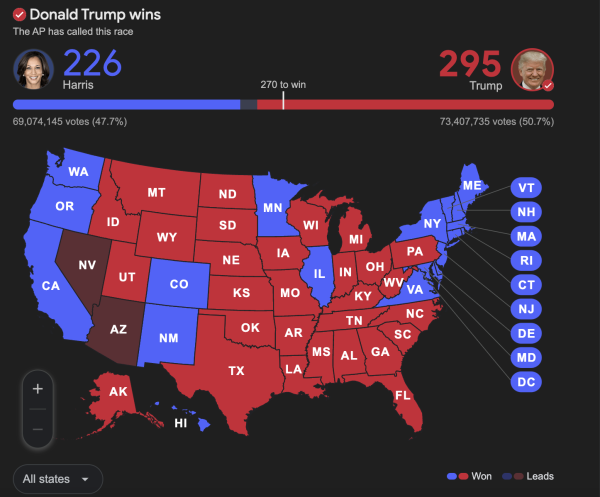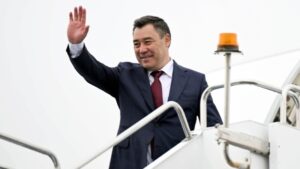With Donald Trump being elected as the next President of the United States, the country’s foreign policy in Central Asia is anticipated to be heavily influenced by external factors. Traditionally, this region has not been a top priority for American presidents. However, shifting geopolitical dynamics, particularly involving China and Russia, are reshaping the U.S. approach to Central Asia. The adoption of the “U.S. Strategy for Central Asia 2019-2025: Advancing Sovereignty and Economic Prosperity” during the Trump administration marked a strategic shift. How do external forces determine U.S. foreign policy in Central Asia? Let’s explore the transactional nature of past engagements, the objectives of the new strategy, and the challenges and opportunities emerging in the region.

Central Asia’s Peripheral Status in U.S. Foreign Policy
A key indicator of Central Asia’s marginal position in U.S. foreign policy is that, historically, no sitting American president had ever visited the region or held a summit with all Central Asian leaders. Central Asia often remained overshadowed by other global priorities. There have been instances where Central Asian leaders visited the United States but did not secure meetings with the American president, underscoring the limited priority given to the region. However, in September 2023, President Biden hosted the first-ever U.S.-Central Asia Summit with the leaders of the five Central Asian countries, signaling a potential shift in engagement. Despite this unprecedented summit, high-level interactions remain infrequent. In 2024, there was only a foreign ministers’ meeting, and it is not known whether there will be meetings at the level of heads of state in the future. This indicates that while there may be increasing attention, Central Asia is still not a primary focus in U.S. foreign policy.
The Transactional Nature of U.S. Engagement
U.S. foreign policy in Central Asia has historically been transactional, often influenced by global events rather than regional priorities. The U.S. engaged in the region not for its intrinsic importance but due to external factors such as the situation in Afghanistan, concerns over China’s control of rare earth elements, and attempts to counterbalance Russia’s historical influence. Military involvement in Afghanistan heightened Central Asia’s strategic importance as a logistical hub and for regional security cooperation. Additionally, the U.S. explored alternative sources of rare earth metals in Central Asia to reduce dependence on China and initiated diplomatic and economic efforts to weaken Russia’s ties in the region.
The “U.S. Strategy for Central Asia 2019-2025”
Adopted during the Trump administration, the “U.S. Strategy for Central Asia 2019-2025: Advancing Sovereignty and Economic Prosperity” signaled a renewed commitment to the region. The strategy aimed to build a more stable and prosperous Central Asia that is free to pursue political, economic, and security interests with a variety of partners on its own terms. The United States emphasized support for the sovereignty and independence of the Central Asian states, aiming to strengthen their resilience against short and long-term threats to their stability.
The strategy outlined six overarching objectives:
- Support Sovereignty and Independence: Enhancing diplomatic engagement and providing assistance to strengthen democratic institutions and economic prosperity, helping Central Asian states function as cooperative partners.
- Reduce Terrorist Threats: Working with Central Asian nations to develop resilience to extremist ideologies and prevent the region from becoming a haven for terrorist organizations.
- Support Stability in Afghanistan: Encouraging Central Asian countries to develop economic and trade links with Afghanistan, contributing to regional stability.
- Encourage Regional Connectivity: Promoting closer ties between Central Asia and Afghanistan across energy, economic, cultural, trade, and security lines.
- Promote Rule of Law and Human Rights: Assisting in developing and implementing justice sector reforms, strengthening civil society, and enhancing government responsiveness.
- Promote U.S. Investment: Working with Central Asian countries to undertake reforms needed to attract more foreign investment, including from American businesses.
The Future of the C5+1 Format Under Trump
The strategy also emphasized the importance of the C5+1 diplomatic platform, which brings together representatives from the five Central Asian states and the United States to address common concerns and promote regional dialogue and cooperation. Under President Trump, the future of the C5+1 format at the presidential level remained uncertain. While the strategy outlined continued support for the platform, the actual engagement depended on the administration’s priorities and responses to initiatives by Russia or China in the region. A lack of U.S. response to significant projects launched by these powers could be perceived as a sign of weakness, potentially diminishing American influence.
Delegating Institutionalization to External Powers
A unique phenomenon in Central Asia is the delegation of institutionalization processes to external actors. Central Asian nations increasingly allow countries like the U.S. and China to guide their institutional frameworks. This raises concerns about the region’s autonomy and the long-term implications for regional integration. The reasons behind this delegation include the slow pace of intraregional integration, where countries often unite only in response to crises and prefer bilateral relations during stable periods. This sporadic cooperation opens the door for external powers to introduce their own formats of cooperation.
The strong involvement of external powers is evident, with Central Asia showing openness to allowing these players to shape the regional agenda. Structures like the B5+1 Business Forums and the China-Central Asia Secretariat exemplify this trend. Moreover, the lack of a central coordinating body, unlike the European Union or ASEAN, makes Central Asia more dependent on external structures to coordinate policies, further enabling external actors to influence the region’s institutional processes.
Impact on Regional Integration
Delegating institutionalization to external actors has both drawbacks and benefits for Central Asian integration. On the downside, relying on external powers may increase their influence over regional affairs, potentially sidelining the interests of Central Asian countries. Engaging with powerful external actors complicates balancing regional priorities with the interests of these powers. The sustainability of commitments also becomes uncertain, as changes in the political dynamics of external actors can affect the continuity and effectiveness of cooperation mechanisms.
On the positive side, external actors facilitate regular summits and dialogues, providing platforms for discussing regional issues. Mechanisms like the C5+1 support long-term goals and projects beneficial to the region. Initiatives aimed at promoting cultural and educational exchanges foster mutual understanding among Central Asian populations. The active joint interaction with external actors forces the states of the region to coordinate actions to some extent, which could strengthen regional unity.
Divergent Approaches of the U.S. and China
The U.S. and China have different strategies in Central Asia. China’s approach focuses on economic integration, infrastructure development, and creating economic dependencies through initiatives like the Belt and Road Initiative (BRI). The emphasis is on building infrastructure, enhancing trade connectivity, and securing access to resources. China’s commitment to institutionalizing its cooperation with the region at the governmental level is exemplified by the establishment of the China-Central Asia Secretariat.
In contrast, the U.S. emphasizes security cooperation, democratic reforms, and building resilience against external influences. The U.S. strategy involves engaging with civil society and the business community through platforms like the B5+1 Business Forums and the C5+1 diplomatic platform. This reflects a shift towards supporting regional economic integration, promoting U.S. private sector trade and investment, and encouraging reforms that attract foreign investment.
Trump vs. Biden Administration Policies
Under Trump, U.S. policy in Central Asia was characterized by a pragmatic, business-oriented approach with less emphasis on democratic reforms and human rights. The focus was on countering Chinese influence and promoting economic and trade relationships. The “U.S. Strategy for Central Asia 2019-2025” emphasized economic engagement, support for sovereignty, and reducing terrorist threats, aligning with a transactional approach.
In contrast, the Biden administration increased high-level diplomatic engagement, emphasizing democratic reforms, social justice, and countering both Russian and Chinese influence. Hosting the first-ever presidential-level C5+1 meeting signaled a renewed commitment to the region. The administration focused on enhancing diplomatic outreach, supporting regional security, and promoting democratic governance, with additional funding committed for economic resilience initiatives.
Potential Impact of Trump’s Re-election
With Donald Trump re-elected as President of the United States, U.S. foreign policy in Central Asia continues to be shaped by external factors. The administration’s aggressive stance toward China includes implementing more severe tariffs and pursuing economic decoupling, which directly impacts Central Asia due to China’s significant presence in the region. The Trump administration is focused on countering China’s influence by promoting alternative infrastructure projects and reducing reliance on Chinese investments. Additionally, Trump has increased trade and military pressure on China and is developing closer cooperation with other Asian countries while maintaining steadfast support for Taiwan. However, given limited resources, the U.S. is concentrating more on strengthening its military presence across Asia.
Regarding Russia, Trump’s potentially more accommodating stance has altered the dynamics in Central Asia, where Russia maintains historical influence. He has sought to reduce support for Ukraine and encouraged European allies to shoulder more of the burden, aiming for a peace process that is more favorable to Russia’s interests. This approach has led to a reduction in U.S. military support to Ukraine, affecting the regional balance of power.
In relation to NATO and the EU, Trump has taken steps to reduce support for these institutions, demanding greater financial contributions from member states. He has renewed threats to limit the U.S. contribution to NATO or withdraw military presence from certain NATO countries. This approach has significant implications for European security and, by extension, for Central Asia.
In the Middle East, Trump continues to support Israel and pursue pro-Israeli policies regarding the Palestinian issue. He has also reinstated tighter sanctions against Iran to maintain U.S. influence in the region, actions that have affected regional stability and impacted Central Asian countries with economic ties to Iran.
In Africa and South America, Trump has reduced aid and interest, pushing these regions out of U.S. strategic priorities. As China’s economic influence in Africa and Latin America grows, Trump has adopted a more cautious policy, which indirectly affects global economic dynamics relevant to Central Asia.
On migration and security, Trump has toughened measures along the Mexican border and developed policies to limit migration from Central America. Domestically, he has also implemented stricter immigration policies, making it more difficult to migrate to the United States.
Challenges and Opportunities for Central Asia
The evolving geopolitical landscape presents both challenges and opportunities for Central Asia. Balancing relationships with major powers is crucial, as engaging with both the U.S. and China requires navigating competing interests while safeguarding sovereignty and regional priorities. Strengthening internal unity and fostering regional cooperation can enhance autonomy. Developing a central coordinating body or adopting models like ASEAN could help reduce dependence on external actors for institutionalization.
Economic development remains a priority. Leveraging external investments for infrastructure and growth is beneficial, but Central Asian nations need to ensure such engagements do not compromise their long-term interests or create unsustainable dependencies. The “U.S. Strategy for Central Asia 2019-2025” emphasizes promoting U.S. investment and development, aiming to create an enabling environment that is transparent, open, and attractive to U.S. businesses. This focus on economic reform and attracting foreign investment can help Central Asian countries strengthen their economies and reduce reliance on any single external actor.
Conclusion
U.S. foreign policy in Central Asia under Trump has been significantly shaped by external factors and strategic considerations involving China and Russia. The adoption of the “U.S. Strategy for Central Asia 2019-2025” marked a renewed, though still transactional, engagement with the region. Central Asian countries face the challenge of navigating these external influences while striving for greater regional autonomy and integration.
Balancing relationships with major powers and fostering internal unity will be crucial for the region’s future stability and development. As external powers continue to shape the institutional landscape of Central Asia, the nations within the region must recognize the importance of asserting their interests. By strengthening internal cooperation mechanisms and engaging with external actors on their own terms, Central Asian countries can work toward a more autonomous and integrated future, less dictated by the agendas of powerful external players. The U.S. strategy’s emphasis on supporting sovereignty, reducing threats, and promoting economic prosperity offers a framework that, if effectively implemented, can contribute positively to the region’s development while aligning with U.S. strategic interests.
Written by: Eldaniz Gusseinov
Eldaniz Gusseinov, is a columnist at Daryo and is a Non-Resident Research Fellow at Haydar Aliyev Center for Eurasian Studies of the Ibn Haldun University, Istanbul.




